Lake Norman, nestled in the heart of North Carolina, is not just a haven for water sports enthusiasts and nature lovers. Beneath its serene surface lies a diverse and vibrant aquatic ecosystem teeming with fascinating fish species. From sleek predators to colorful game fish, this sprawling lake offers a rich tapestry of underwater life.
In this article, we invite you to dive into the depths of Lake Norman and discover nine amazing fish that call this picturesque lake their home. Whether you’re an avid angler seeking new fishing adventures or simply curious about the wonders of aquatic life, you’ll love the remarkable diversity found within these waters.
1. Largemouth Bass

To catch largemouth bass in Lake Norman, anglers can employ various techniques.
©Maclane Parker/Shutterstock.com
Largemouth bass, scientifically known as Morone chrysops, is a popular freshwater game fish renowned for its size and strength. It can grow up to 2 feet in length and weighs over 10 pounds. This species has a broad mouth and dark greenish coloration, often accompanied by a series of dark stripes along its sides.
Lake Norman has gained a reputation for its exceptional largemouth bass fishing due to its ideal habitat conditions and abundant prey. The lake’s diverse structure, including submerged vegetation, rocky areas, and submerged timber, provides ample hiding places for the bass. Additionally, the presence of baitfish like shad and bluegill contributes to the bass population’s health and growth.
To catch largemouth bass in Lake Norman, anglers can employ various techniques. Try using plastic worms, jigs, or crankbaits near structure-rich areas. Casting along weed edges, drop-offs, and points can yield great results. Additionally, topwater lures, such as poppers and buzzbaits, can be effective during low-light conditions or when bass are actively feeding near the surface. It’s crucial to adapt to the seasonal patterns and adjust bait choices accordingly. Patience, observation, and experimenting with different techniques will enhance the chances of a successful largemouth bass fishing experience in Lake Norman.
2. Striped Bass
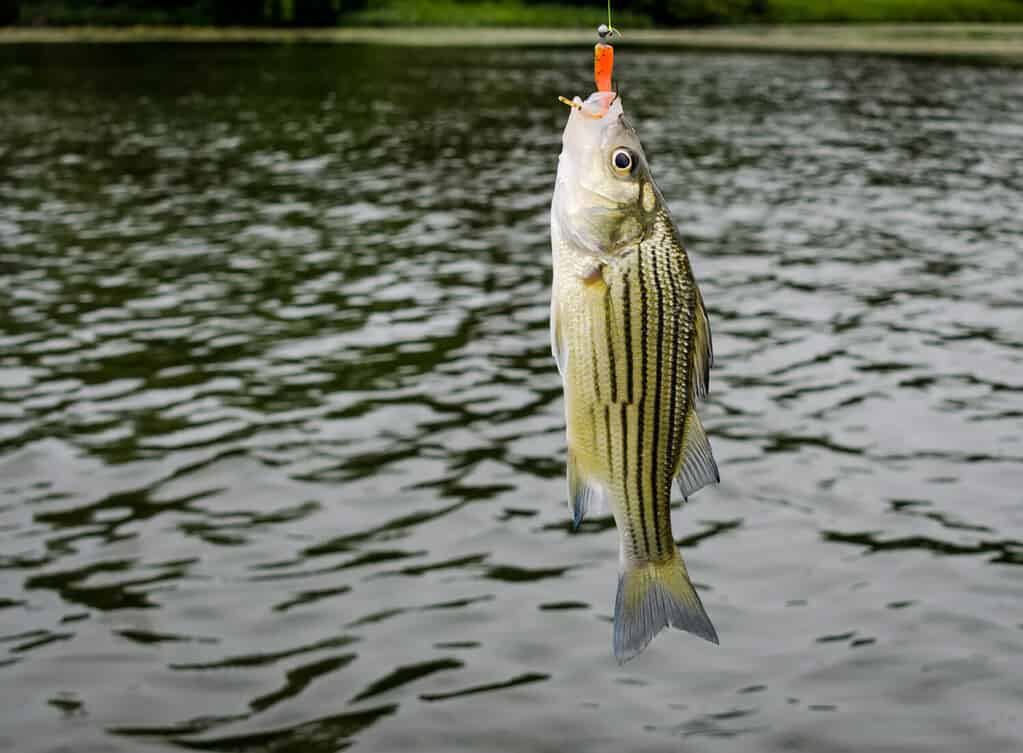
Lake Norman serves as a prime habitat for striped bass.
©HildeAnna/Shutterstock.com
Striped bass (Morone saxatilis), also known as stripers or rockfish, are highly sought-after saltwater and freshwater game fish known for their strength and size. They have a streamlined body with dark, olive-green coloring along their back and silver-white sides, accompanied by distinct horizontal stripes. Striped bass can grow up to several feet in length and weigh over 50 pounds, making them a thrilling catch for anglers.
The unique appeal of striped bass fishing in Lake Norman lies in the excitement of targeting these migratory fish in a freshwater setting. Lake Norman serves as a prime habitat for striped bass, offering abundant forage and suitable water temperatures. Anglers yearn for the challenge of hooking into these hard-fighting fish within the lake’s vast waters, providing an exhilarating fishing experience.
The best times to target striped bass in Lake Norman are during their seasonal migrations. In spring and fall, when water temperatures are cooler, stripers move closer to the surface and feed more actively. Trolling with live bait, such as shad or herring, or using artificial lures like swimbaits or jerkbaits can be effective techniques for enticing strikes. Fishing near points, drop-offs, and underwater structures can increase the chances of success. It’s important to stay informed about local regulations and recommended fishing practices to ensure the sustainability of striped bass populations in Lake Norman.
3. White Bass
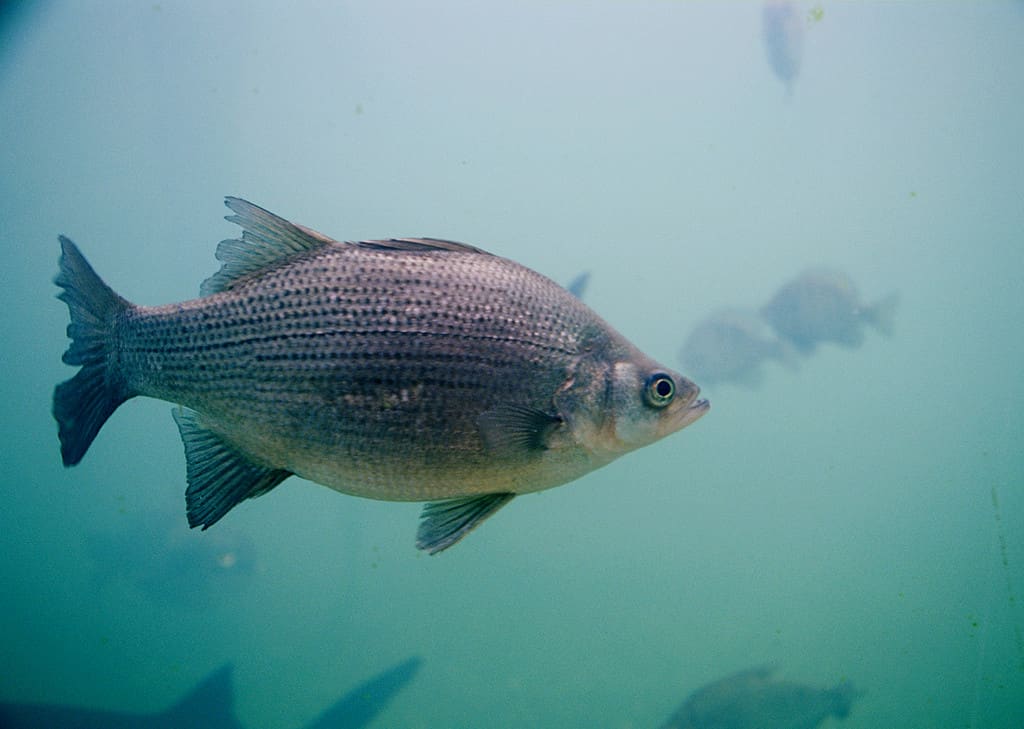
These bass live near the mouths of creeks and along rocky shorelines.
©Eric Engbretson / Public domain – License
White bass, scientifically Morone chrysops, are a popular freshwater game fish featuring schooling behavior and energetic fights. They have a silvery-white body with dark horizontal stripes along their sides and a deeply forked tail. White bass typically range in size from 10 to 15 inches and can weigh up to two pounds.
The unique appeal of white bass fishing in Lake Norman lies in the excitement of targeting these schooling fish in a freshwater environment. Lake Norman offers ample opportunities for anglers to locate and target white bass, especially during their spawning migrations. The aggressive feeding behavior and frenzied schooling habits of white bass add to the thrill of the catch.
The best times to target white bass in Lake Norman are during their spring and fall spawning runs. They reside near the mouths of creeks and along rocky shorelines. Trolling with small crankbaits, casting with spoons or jigs, and using live bait such as minnows or worms are effective techniques to entice white bass strikes. Paying attention to water temperature, wind direction, and light conditions can also improve success rates.
4. Spotted Bass
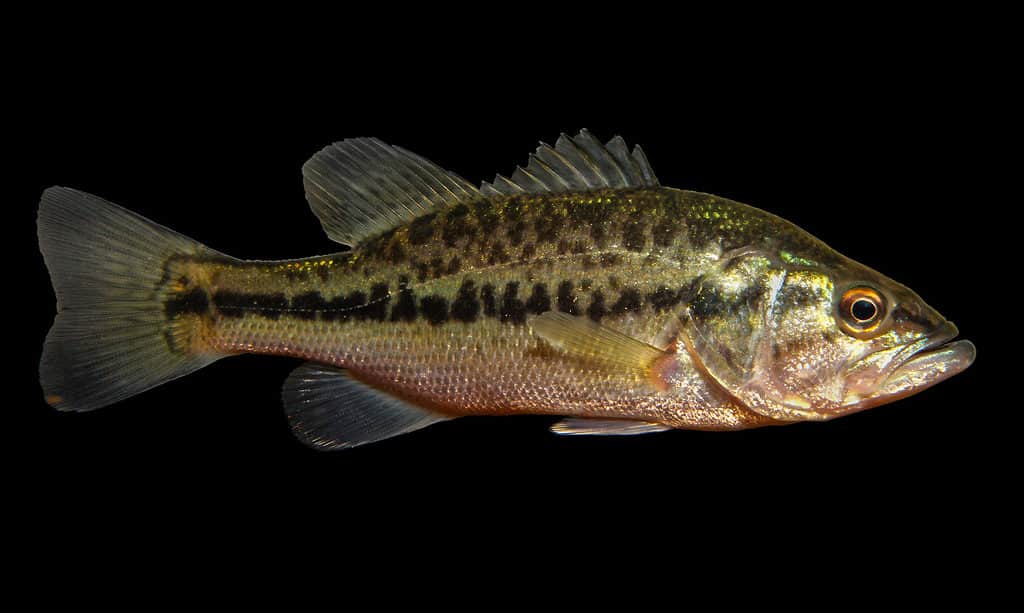
Lake Norman’s diverse structure provides ideal habitat for spotted bass to thrive.
©Sean McVey/Shutterstock.com
Spotted bass, scientifically known as Micropterus punctulatus, are a prized freshwater game fish known for their aggressive nature and acrobatic fights. They have a similar appearance to largemouth bass, but with distinct characteristics. Spotted bass have a rough patch on their tongue and rows of dark spots along their lower sides, giving them their name. They typically grow between 12 and 17 inches in length and can weigh up to five pounds.
The unique appeal of spotted bass fishing in Lake Norman lies in the challenge they present to anglers. Known for their cunning behavior and strong fights, spotted bass offer an exciting fishing experience. Lake Norman’s diverse structure, including submerged rocks, points, and brush piles, provides ideal habitat for spotted bass to thrive, making it an attractive destination for anglers seeking a rewarding catch.
The best times to target spotted bass in Lake Norman are during the early morning and late afternoon when they are most active. Techniques such as using finesse baits, such as soft plastic worms or jigs, around rocky areas and drop-offs can be effective. Casting near submerged structures and utilizing techniques like flipping or pitching can also yield success. It’s important to experiment with different retrieves and adapt to the changing conditions to entice strikes from these elusive bass. Always abide by fishing regulations and practice responsible catch-and-release to preserve the spotted bass population in Lake Norman.
5. Black Crappie
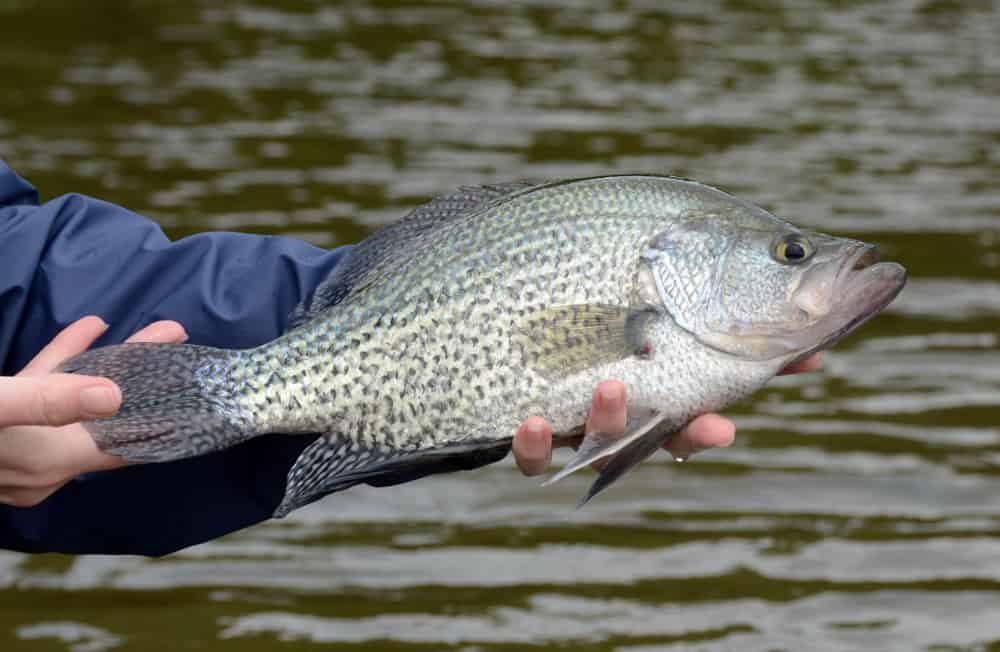
Practicing catch-and-release for larger fish will help sustain the black crappie population in Lake Norman.
©M Huston/Shutterstock.com
Black crappie, scientifically known as Pomoxis nigromaculatus, are a popular freshwater game fish known for their delicious taste and striking appearance. They have a deep, compressed body with a mottled pattern of black spots on a silvery background. Black crappie prefers to inhabit clear, fertile waters with submerged vegetation and structure, such as brush piles and fallen trees. In Lake Norman, they can be found in the shallower areas and around docks.
Black crappie fishing is highly popular in Lake Norman due to the lake’s abundant crappie population. Anglers are drawn to the lake’s reputation for producing good-sized crappie and the opportunity for a successful day on the water. The healthy crappie population ensures a consistent fishing experience for both beginners and experienced anglers.
To effectively catch black crappie in Lake Norman, anglers can utilize different strategies. Techniques such as vertical jigging with small jigs or live minnows near submerged structures and drop-offs can be fruitful. Slowly retrieving the bait with occasional twitches can imitate the natural movement of prey and attract crappie. Using light tackle and adjusting the depth according to the crappie’s feeding patterns are essential. It’s also beneficial to fish during low-light conditions or early morning and late evening when crappie are more active. Adhering to local fishing regulations and practicing catch-and-release for larger fish will help sustain the black crappie population in Lake Norman.
6. White Crappie

, or white crappie, prefers to inhabit calm waters with clearer visibility.
©iStock.com/Jenniveve84
White crappie, scientifically known as Pomoxis annularis, are a highly sought-after freshwater game fish known for their delicate flavor and distinctive appearance. They have a deep, laterally compressed body with silver scales and vertical dark bars along their sides. White crappie prefers to inhabit calm waters with clearer visibility and prefer submerged vegetation and woody cover, such as brush piles and fallen trees. In Lake Norman, they can be found in deeper areas with structure.
White crappie fishing is immensely popular in Lake Norman due to the lake’s abundant crappie population. Anglers flock to the lake for the opportunity to catch good-sized crappie and enjoy a productive day on the water. The thriving crappie population ensures a consistent and rewarding fishing experience for enthusiasts of all skill levels.
To successfully catch white crappie in Lake Norman, anglers can employ various strategies. Vertical jigging with small jigs or live minnows near submerged structures, brush piles, or docks can be effective. Slowly retrieving the bait with gentle twitches can imitate the natural movement of prey and entice white crappie to strike. Fishing at different depths and adjusting to the crappie’s feeding patterns are crucial. It’s beneficial to fish during low-light conditions or early morning and late evening when crappie are more active. Adhering to fishing regulations and practicing responsible catch-and-release will ensure the sustainability of the white crappie population in Lake Norman.
7. Blue Catfish

Blue
catfish
in Lake Norman exhibit both nocturnal and diurnal feeding habits.
©Thomsonmg2000, cropped and adjusted by Kostka Martin / CC0 – License
Lake Norman is home to various species of blue catfish, including the channel catfish (Ictalurus punctatus) and the flathead catfish (Pylodictis olivaris). These species are highly prized by anglers for their size and fighting ability. Blue catfish, in particular, are known for their distinctive bluish-gray coloration and deeply forked tails. They can grow to impressive sizes, with some specimens reaching weights exceeding 100 pounds.
Blue catfish in Lake Norman exhibit both nocturnal and diurnal feeding habits. They are opportunistic predators, feeding on a wide range of prey, including fish, insects, and crustaceans. These catfish often inhabit deep holes, channels, and areas with structure, such as submerged logs and rock piles. They are known for their strength and tenacity, putting up a spirited fight when hooked.
To target blue catfish in Lake Norman, anglers can employ various techniques. Bottom fishing with cut bait, such as shad or bluegill, is a popular method. Setting up multiple rods with different baits and depths can increase the chances of success. Drifting or trolling along channels and drop-offs can also yield results. Using heavy tackle and strong hooks is essential to handle the power of blue catfish. Patience is key, as blue catfish are known to be selective feeders at times.
8. Channel Catfish

Channel catfish are known for their adaptability.
©Aleron Val/Shutterstock.com
Lake Norman is home to various species of catfish, including the popular channel catfish (Ictalurus punctatus). Channel catfish are highly sought after by anglers for their delicious flavor and feisty nature. They are characterized by their slender bodies, deeply forked tails, and distinct dark spots along their sides.
Channel catfish in Lake Norman can vary in size, with adults typically ranging from 12 to 24 inches in length and weighing up to 15 pounds. They are opportunistic feeders and can be found in a variety of habitats, including deep holes, rocky areas, and around submerged structures. Channel catfish are known for their adaptability and can tolerate a wide range of water conditions.
To target channel catfish in Lake Norman, anglers can use a variety of techniques. Bottom fishing with natural baits, such as chicken liver, nightcrawlers, or prepared stinkbaits, is a popular and effective method. Fishing at night or during low-light conditions can increase the chances of success, as channel catfish are more active during these times. It’s important to use appropriate tackle, including strong hooks and line, as channel catfish can put up a spirited fight.
9. Flathead Catfish
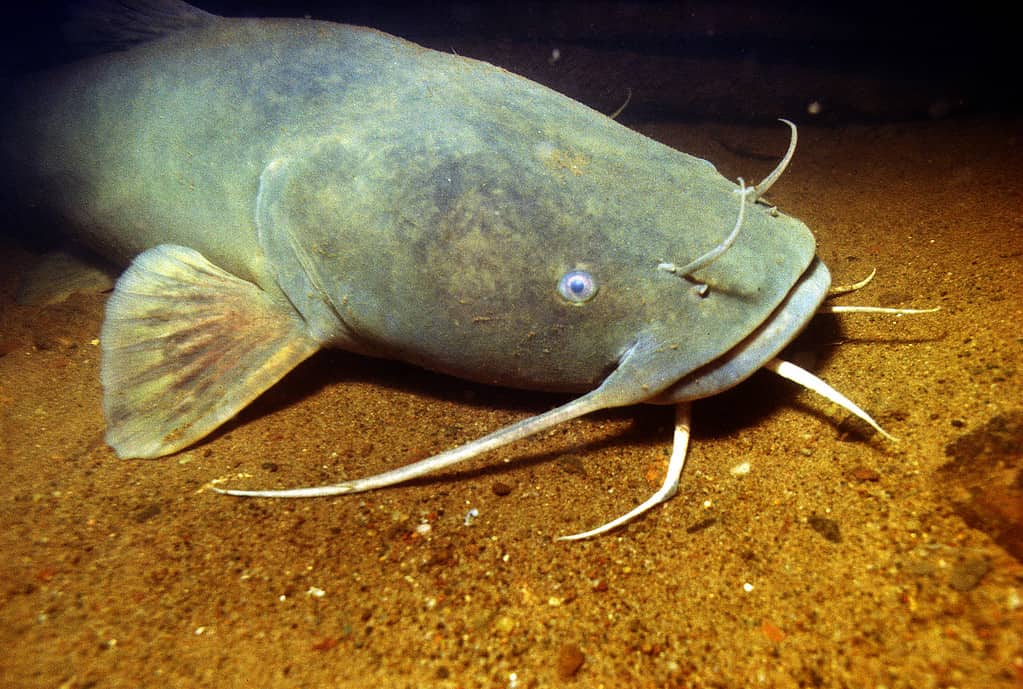
A sturdy fishing line is necessary to handle the power of these large catfish.
©stammphoto/ via Getty Images
Lake Norman is home to various species of catfish, including the revered flathead catfish (Pylodictis olivaris). Flathead catfish are highly sought after by anglers for their impressive size and challenging fights. They are characterized by their wide, flat heads, mottled brown or yellowish-brown coloration, and a prominent lower jaw.
Flathead catfish in Lake Norman can grow to exceptional sizes, with adults reaching lengths of over 40 inches and weighing more than 50 pounds. They are primarily nocturnal hunters, preferring to hide during the day and actively seeking prey at night. Flathead catfish are known for their preference for live bait, such as small fish, crayfish, and even large insects.
To target flathead catfish in Lake Norman, anglers can use various techniques. Fishing with live bait, such as sunfish or shad, is highly effective. Locating areas with submerged structures, such as fallen trees or submerged logs, is key as flathead catfish often use these as ambush points. Fishing at night or during low-light conditions can increase the chances of success. Using heavy tackle, strong hooks, and a sturdy fishing line is necessary to handle the power of these large catfish.
In Conclusion
The waters of Lake Norman in North Carolina are truly a treasure trove for both fish enthusiasts and nature lovers. Throughout this article, we’ve explored the diverse array of fish species that call this picturesque lake their home, from the mighty flathead catfish to the acrobatic largemouth bass.
As you venture out onto the tranquil waters of Lake Norman, armed with newfound knowledge and techniques, remember to practice responsible fishing and follow local regulations to ensure the sustainability of these fish populations for generations to come. Let’s continue to cherish and protect the incredible fish species that make Lake Norman a truly remarkable destination.
The photo featured at the top of this post is © jdwfoto/iStock via Getty Images
Thank you for reading! Have some feedback for us? Contact the AZ Animals editorial team.






